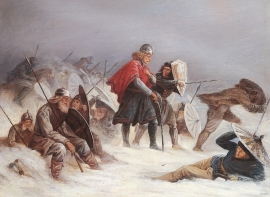- Remove Smallholdings filter Smallholdings
- Remove Igneous rocks filter Igneous rocks
- Remove Sedimentary rocks filter Sedimentary rocks
- Remove Chieftains and royal lines filter Chieftains and royal lines
- Remove Waterfalls filter Waterfalls


Støle
High above the sea and the beach flats, on one of the wide terraces shaped by the sea and the ice, lies the farm Støle (Stødle). The Old Norse name of Studla is derived from studill “support, shelf”. As far back as Viking times Støle has been a chieftain’s farm, a good farm on the plains formed by the moraine masses.




Måbødalen- geology
The old pack road had 1500 steps, where cars today gas through the mountain. The time of this hard work is over, and of getting used to the steep terrain, as well; only the view from the top is much the same as before. Vøringsfossen in summer is one of Western Norway’s biggest natural wonders. It marks the transition between the older, open part of the Sysendalen valley and the younger, narrow and winding valley of Måbødalen.


Låtefossen
Låtefossen waterfall, or more correctly, waterfalls, plunge 165 metres down the mountainside, 51 of them in free fall - to the enchantment of the many tourists along the highway below. The spectacular view is mainly seen from the stage of the Storelvi river in the valley below the waterfall.

Steinsdalsfossen
Øvsthusfossen, or Steinsdalsfossen waterfall, as it is called today, attracts tourists by the thousands, and always has done as long as there have been tourists in Norway, since the early 1800s.

Trail toward Kyrkjedøri
Roughly 550 million years ago, what is now Finse lay at the bottom of the sea - the remains of mud and clay that were deposited in this sea have ended up on the roofs of Norway. Also the thrust sheet from the continental collision has found its way to Finse, after a several hundred kilometre-long, trek through the mountains, that took several tens of millions of years to complete.


